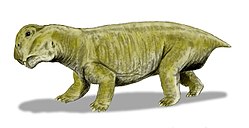| Kannemeyeriiforms Temporal range: Triassic, | |
|---|---|
 | |
| Restoration of Stahleckeria potens | |
| Scientific classification | |
| Kingdom: | Animalia |
| Phylum: | Chordata |
| Clade: | Synapsida |
| Clade: | Therapsida |
| Clade: | † Anomodontia |
| Clade: | † Dicynodontia |
| Infraorder: | † Dicynodontoidea |
| Clade: | † Kannemeyeriiformes von Huene, 1948 |
| Subgroups | |
Kannemeyeriiformes is a group of large-bodied Triassic dicynodonts. As a clade, Kannemeyeriiformes has been defined to include the species Kannemeyeria simocephalus and all dicynodonts more closely related to it than to the species Lystrosaurus murrayi .





